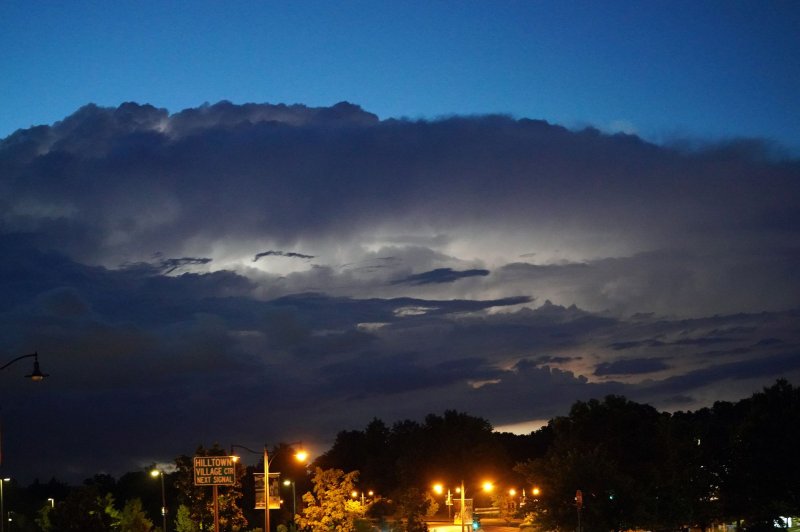
Thunderstorms could aggravate symptoms of asthma and COPD in older adults, causing an increase in emergency-room visits, a new study has found.
Photo by Bill Greenblatt/UPI | License Photo
Aug. 10 (UPI) -- Thunderstorms are associated with an average of more than 3,000 additional emergency room visits annually among older adults with asthma and COPD in the United States, according to a study published Monday by JAMA Internal Medicine.
Based on the analysis of weather patterns and health information for Medicare beneficiaries 65 and older, more than 50,000 additional ER visits occurred among seniors with the respiratory conditions over a 14-year period between the 1999 and 2012, the researchers said.
Temperature rises and increases in air pollution in the days leading up to these storms could have aggravated breathing-related symptoms, causing people to seek emergency medical care, the researchers said.
"The environment and climate can affect our health, and with the changing climate, we will need to anticipate changes in healthcare needs," study co-author Dr. Christopher Worsham told UPI.
Aug. 10 (UPI) -- Thunderstorms are associated with an average of more than 3,000 additional emergency room visits annually among older adults with asthma and COPD in the United States, according to a study published Monday by JAMA Internal Medicine.
Based on the analysis of weather patterns and health information for Medicare beneficiaries 65 and older, more than 50,000 additional ER visits occurred among seniors with the respiratory conditions over a 14-year period between the 1999 and 2012, the researchers said.
Temperature rises and increases in air pollution in the days leading up to these storms could have aggravated breathing-related symptoms, causing people to seek emergency medical care, the researchers said.
"The environment and climate can affect our health, and with the changing climate, we will need to anticipate changes in healthcare needs," study co-author Dr. Christopher Worsham told UPI.
RELATED Even as air pollution declines, disparities in exposure remain
"With the expectation that storms will be more severe with rising global temperatures, we should expect a modest, but real, increase in care needs among older adults, particularly those with asthma and COPD," said Worsham, a pulmonologist and critical care physician at Harvard Medical School.
About 7% of all U.S. adults 65 and older have asthma, and roughly 14% have COPD, or chronic obstructive pulmonary disorder, the U.S. Centers for Disease Control and Prevention estimates.
Both conditions cause breathing difficulty and can lead to severe illness and death, particularly in older adults, according to the Asthma and Allergy Foundation of America.
Earlier studies have identified a phenomenon known as "thunderstorm asthma" in which outbreaks of older adults with worsening breathing problems occur, Worsham said.
These "outbreaks" are believed to be caused by ruptures of pollen spores in the days leading up to a storm, he said. These spores get blown around by a storm, causing sensitive people to have asthma attacks both during and shortly after the weather events.
For the research, Worsham and colleagues used publicly available atmospheric and lightning data from the National Oceanic and Atmospheric Administration for all 3,127 counties nationwide from January 1999 to December 2012.
RELATED Small reductions in air pollution can reduce heart disease threat
They combined this data with insurance claims and health information for more than 46 million Medicare beneficiaries older than 65 to identify emergency room visits with acute respiratory diagnoses, they said.
Just over 10% of those included in the analysis had chronic asthma, while more than 26% had COPD and 6.6% had both, researchers said.
More than 22.1 million ER visits related to respiratory problems occurred across 822,000 days with "major thunderstorms," defined as weather events that included lightning, precipitation and above-median wind speeds, during the 14-year study period, the researchers said.
Approximately 52,000 of these visits involved older adults with asthma and COPD, which equates to more than 3,700 per year.
"We saw that it is the weather changes before the storm that seem to drive emergency department visits," Worsham said.
"Anyone with asthma or COPD who typically has worsening symptoms around storms should make sure to use their inhalers as recommended by their physician, and make sure a rescue inhaler is available to them when a storm is in the forecast," he said.
upi.com/7028032
No comments:
Post a Comment